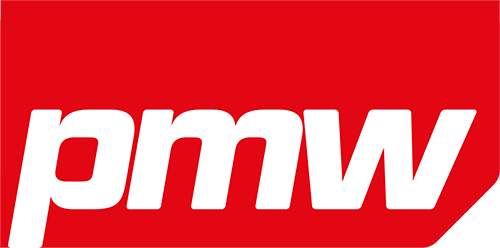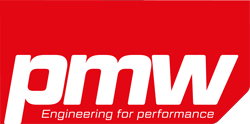In the July Issue of Tire Technology International, Trinity Francis spoke to the team at Giti and learnt the intricate details behind the development of its tire for the British Truck Racing Championship
The British Truck Racing Championship (BTRC) is a UK-based motorsport series that is marking its 40th anniversary this year. This type of truck racing was first seen in the USA in 1979 before the sport made it to Europe. For the 2024 season, nine drivers across eight teams in Division 1 and three drivers across three teams in Division 2 will compete at seven events. Division 1 includes highly customized race-prepared machines with bespoke braking and suspension systems while Division 2 vehicles more closely resemble production variants.
The series commenced at Brands Hatch and visits Pembrey, Thruxton, Donington and Snetterton, returning to Brands Hatch for the final race in November. For the first time, 2024 will see the penultimate race held at the Le Mans Bugatti circuit. At each track, competitors take part in five 15-minute races to decide the leaderboard.
Competitors race in commercial vehicles that have more than 1,000bhp, over 5,000Nm of torque and weigh in between 5 and 5.5 tons. Top speed is limited to 99mph (160km/h) so quick acceleration is key. The two-axle vehicles wear six tires, with four at the rear. The rules state that teams cannot camber the front wheels. All positions wear the same tire, supplied by the official tire partner, Giti Tire.
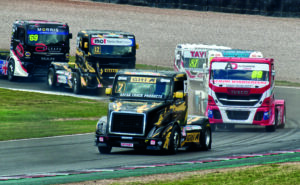
In 2017, Giti launched its racing truck tire, supplying tires for the Australian Super Truck Nationals. This series is similar to the BTRC so the Giti tire, which is manufactured in China, is used for both.
“The Giti 315/70 R22.5 Race-Tuned V1 is specifically built for commercial vehicle racing,” says Alistair Brown, technical manager at Giti Tire. “Aesthetically, there are two main differences between a standard road-going truck tire and the race tire: the asymmetric design and the shallow tread depth, which is less than half of the depth you’d expect to see on a new truck tire.”
Shoulder design, structure and pressure
From a tire structural perspective, the asymmetric design features an inside shoulder that is stiffer and has a squarer profile, while the outside shoulder is more rounded. For straight-line handling, the inside shoulder provides enhanced stability and traction.
“The rounded outside shoulder is great for cornering stability and under hard cornering the vehicle is able to roll over the shoulder,” Brown says.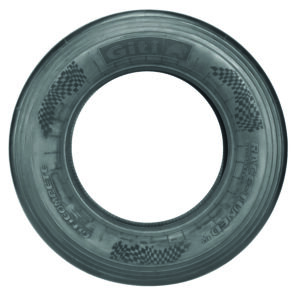
This disparity between the forces applied to each shoulder means the tire must have a robust internal structure. The Race-Tuned V1 tire has a load index of 154 and has far less weight to carry, compared with a truck and trailer combination, which can weigh up to 44 tons in a typical on-road application.
“Structurally, the tire is around 95% the same as the road-going tire with tweaks to the bead characteristic and sidewall stiffness for racing,” explains Brown.
The competition tires also tend to be run at far lower pressures than would typically be seen on road variants of these vehicles.
“On average in the rear tires, pressures are around 30psi, and close to 60psi in the front tires, whereas road-going truck tires would run at around 90psi in the rear and 120psi in the front,” Brown says.
This optimizes the footprint of the tire, which has a section width of 320mm.
Tread pattern
To match the asymmetric shoulder design, the tread pattern is also asymmetrical. The tread features two longitudinal 5.3mm-deep grooves to maximize water evacuation and reduce aquaplaning incidents. The same tire must be used in all weather conditions, so water drainage is a key characteristic to balance with grip on dry or wet circuits.
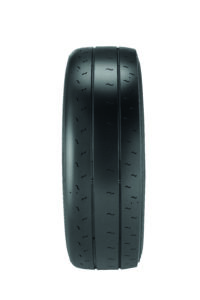 “Ideally we would make a racing slick like you have within standard motorsport, but we can’t because we use the same tire for all the races,” admits Brown. “Instead, we have a longitudinal groove at the minimum level so we can offer the same feeling of a racing slick. If the tread depth was any higher the tire’s performance would be affected.”
“Ideally we would make a racing slick like you have within standard motorsport, but we can’t because we use the same tire for all the races,” admits Brown. “Instead, we have a longitudinal groove at the minimum level so we can offer the same feeling of a racing slick. If the tread depth was any higher the tire’s performance would be affected.”
Sipe depth is 3.5mm and the shape, orientation and distribution of the sipes is designed to deliver good grip and traction during cornering and straight-line driving. This also supports even tread stiffness and pressure across the contact patch, which helps to extend the life of the tire throughout a race.
Each shoulder features two rows of wear indicators. This is an important feature that can help
to inform the position of the tire on the vehicle. The steer axle has greater exposure to lateral forces so the tread covering the shoulder will wear much more quickly than the outside shoulder on the rear axle.
“Once the wear indicators disappear, that means the team needs to be replacing or moving that tire to a different position. It’s a visual indicator of lateral scrub – which doesn’t mean the entire tread is worn down, but it prevents wear through to the base compounds on the outside shoulder,” Brown explains.
Compounding
As well as wear, tire position is dictated by heat cycles.
“Normally teams put new tires on the inside rear axle position where they go through a heat cycle, and then get moved to the front axle,” says Brown. “From the front axle the tires are then moved to the outer rear axle position once they are worn down below the wear indicators. A set of six tires should complete a race weekend if they are well looked after.”
Some tracks used in the series are more abrasive than others, and if vehicle contact occurs and a tire sustains damage then a pair might need replacing prematurely.
The compound uses a special polymer and functional resin to improve grip and handling. Nanofiller offers better stiffness and strength, and the carbon black-silica blend gives the tire increased tear resistance.
“The compound is designed to run optimally between 80°C and 100°C depending on tire pressure, track conditions and weather conditions,” Brown says.
Additional benefits
As for all tire makers that sponsor motorsport series, there are several additional benefits to the company beyond merely supplying a tire. First, from a marketing perspective, truck racing reaches a new audience of potential customers. While BTRC has a comparatively low viewership compared with other more prominent motorsports, its audience and teams are arguably more likely to need tires for road haulage and transportation applications.
In 2022, the BTRC saw 100,000 fans descend on Brands Hatch over the Easter weekend. Alongside fans attending in person, in 2023 social media coverage and race live streams amassed nearly half a million views. Given that the Race-Tuned V1 uses a similar casing construction to Giti’s on-road truck tires, the racing series is an ideal platform to showcase the durability of the company’s tires in the most extreme conditions.

Unlike race series that use performance sports cars whose tires are suitable for individual customers, commercial vehicle racing is an opportunity to appeal to fleets where tire sales will likely include solutions for trucks and trailers across a business. Giti’s on-road tire offering covers regional, long-haul, eco, combi, mixed, urban and winter applications.
In the commercial vehicle segment, tire makers also have greater opportunity to offer services beyond the tire itself. Giti offers two digital solutions: Giti Fleet Services is a tire-focused platform that handles maintenance, quality monitoring, retreading, technical support and 24-hour roadside assistance; and Mercury Fleet Management is a cloud-based platform with an app to handle fleet operations from job sheets and service items to casing control and invoicing.
And, perhaps most importantly, as well as driving customers toward its digital and physical fleet products, truck racing makes for an ideal R&D testbed for Giti, offering a chance to push its tires to the most extreme limits of existing technology.
European Truck Racing Championship
The tire for the European truck series is developed by Goodyear The European Truck Racing Championship (ETRC) is a similar FIA series. The season consists of seven events around Europe, this year starting in Italy at Misano, before moving on to the Slovakia Ring, the Zolder Circuit in Belgium, the Nürburgring in Germany, Autodrom Most in the Czech Republic, Le Mans Bugatti in France, and concluding in Spain at the Jarama Circuit in October.
Goodyear is the long-standing tire partner for the ETRC, and 2024 will be the tire maker’s ninth consecutive season supplying the series, having been involved with developing tires for truck racing since 2003. The original offering was buffed standard Goodyear Regional 315/70 R22.5 RHS truck tires. Since then, Goodyear has developed a racing-specific tread and compound at its Innovation Center in Luxembourg.
 This year the company introduced a new racing compound to improve grip, especially in wet conditions. The tires were tested by Goodyear FIA ETRC drivers at its proving grounds and circuits across Europe to determine their suitability for the sport. The new compound is combined with an optimized contact patch to promote even wear and consistent performance over the lifespan of the tire.
This year the company introduced a new racing compound to improve grip, especially in wet conditions. The tires were tested by Goodyear FIA ETRC drivers at its proving grounds and circuits across Europe to determine their suitability for the sport. The new compound is combined with an optimized contact patch to promote even wear and consistent performance over the lifespan of the tire.
The FIA does not allow retread or remold tires to be used in competition. The ETRC has committed to reach net zero by 2038 so part of this initiative involved reducing the impact of the tire.
Since 2022, Goodyear has been retreading its tires after competition to be used on road-going commercial vehicles. Goodyear bases its truck racing tires on its casings for on-road trucks so, provided no damage is sustained to the casing during a race, these can be repurposed.
Like the BTRC, all tires used must be the same on every axle in all weather conditions. As well as ICE trucks, which run on HVO (a switch the series made in 2021), the ETRC now allows electric, hybrid and bio-LNG-powered vehicles. This is likely to drive further tire development to offer sports car grip and performance for trucks that weigh in excess of five tons.
